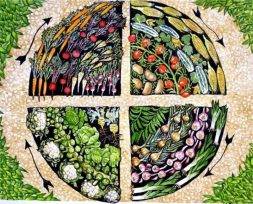Crop rotation-importance and benefits.
According to wikipedia, Crop rotation is the practice of growing a series of dissimilar or different types of crops in the same area in sequenced seasons.
I would formulate crop rotation as scientifically based rotation of crops in time and space (or by years and fields) or only in time.
Rotation of crops over time is changing them over the years on the same field. Rotation across fields means that each crop passes through all fields sequentially.
Crop rotation is one of the main elements of sustainable agriculture, farm management and crop production. It provides the basis for all agronomic activities, in particular-soil treatment activities, fertility programs, measures to combat soil erosion, and protection of crops from weeds, diseases, and pests.
Crop rotation contributes to the replenishment and better use of soil nutrients and fertilizers, improving and maintaining favorable physical and biological properties of the soil, protecting it from water and wind erosion, preventing the spread of weeds, diseases and pests, reducing the pesticide load on the fields and obtaining high-quality products.
Why crop rotation is so important for sustainable and predictable crop production.
All agricultural crops react negatively to repeated crops and permanent cultivation in the same place. In some crops, this is manifested by a slight decrease in yield, in others-a sharp decline and death of crops. According to Canola Council, canola seeded into canola stubble yields 10% to 20% less, in general, than canola seeded into cereal or pulse stubble. In a rotation that has canola every second year, growers should increase the level of pest management diversity by using different modes of action for weed, disease and insect control…..
The main reasons of need of crop rotation are:
-Physical;
The physical reasons for the need to rotate crops are due to their influence on the structure, density, water regime of soils and resistance to erosion processes. Some crops, for example, perennial grasses, due to a large volume of plant residues, replenish the balance of organic matter, thereby significantly improving its agrophysical conditions and fertility. Others, on the contrary, have a negative impact because of their significant depletes of humus and organic matter in the absence of organic fertilizers, as a result of which the soil fertility also declines. Appropriate soil treatment allows you to create optimal soil regimes for plant life.
-Chemical;
The chemical reasons of crop rotations are caused by a disproportion in the balance of mineral nutrients, with permanent cultivation of the same crops on the same fields. For example, leguminous crops accumulate nitrogen in the soil, which is lost by the soil during the replant. Seeding of grain crops on legumes stubble in the next year allows using the accumulated nitrogen for the formation of the crop and reduce expenses on production.
Chemical causes include the balance of organic matter, which is an integral indicator of soil fertility. Different crop groups have different effects on the amount of organic matter in the soil. Some, for example, perennial grasses leave a large amount, positively affecting subsequent crops, while others, for example, row crops deplete the supply of humus.
-Biological;
Biological reasons for crop rotation are explained by the accumulation of specific pests, pathogens and weeds in repeated and permanent crops, which, in general, strongly affects the yield. In addition, the plants are also affected by the specific substances of the same crop accumulated in the soil, which leads to the manifestation of the effect of soil fatigue.
-Economic.
Economic reasons for crop rotation are due to organizational and technological factors of production. Farmers can plan expenses far ahead, reduce stress, increase productivity, predict year income, develop a long-term budget…
To sum up, crop rotation is a useful practice to increase farm profitability, reduce stresses, improve soils and diversify farm business. Certainly, number of factors, such as market, farm size, labor supply, climate, soil type, growing practices, available equipment etc… must be taken into consideration when planning a crop rotation. Talk to your professional advisers to help you to develop crop rotation that fits your business best.
Read article written by Sherrilyn Phelps PAg Regional Crops Specialist North Battleford and Shannon Urbaniak PAg Regional Crops Specialist Prince Albert Saskatchewan to get more ideas for your business.


